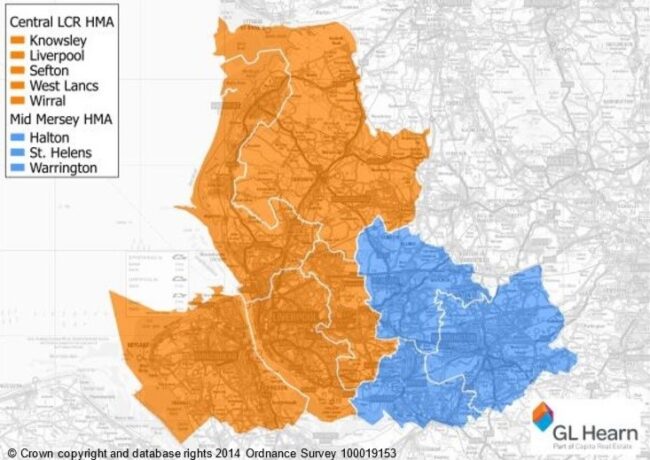Liverpool edges towards spatial framework
Liverpool City Region Combined Authority and West Lancashire Council have published a draft Strategic Housing and Employment Land Market Assessment, a key stage in putting together its Single Spatial Framework to guide development up to 2037.
The 190-page SHELMA will also come into play as the seven local authorities concerned revise their respective Local Plans.
GL Hearn was commissioned to write the draft SHELMA for the Combined Authority, which is inviting technical comments to be submitted up to 31 October.
Although only published in the last week, the work was carried out at the start of thus year, prior to the Government’s recent consultation on standardising objectively assessed housing need methodology, with GL Hearn noting that this should be factored in. The issue this could raise is that the government’s proposed methodology would see a significant reduction in housing growth numbers for the North of England as a whole.
Another point is that Liverpool’s housing numbers look set to rise in comparison to other parts of the city region, which could raise questions over delivery.
The report has been welcomed by planners. Dan Mitchell, partner at Barton Willmore, told Place North West: “We’re pleased that Liverpool City Region is thinking about its growth aspirations, including West Lancashire, so we welcome this initial consultation. Economic aspirations need to be scrutinised along with housing numbers, we need to see how this aligns with the region’s economic objectives.”
The housing numbers suggested are based in part around projected employment growth, and the report sets out baseline and growth scenarios based on figures provided to Oxford Economics by the Liverpool City Region LEP on growth ambitions and targets, centred on sectors identified as having potential. Each local authority also provided development proposals and projects.
In job growth terms, the combined baseline full-time equivalent jobs growth figure is 52,800 between 2012 and 2037, and in the growth scenario it is 119,700 extra jobs.
This feeds into projections on economic-based housing need. It is suggested that the projected housing need, in dwellings per year for the city region, factoring in Warrington as part of the Functional Economic Market Area, is 4,015 as a baseline figure, with 6,122 in the growth scenario. For Liverpool specifically, those figures are 862 and 1,791 residential units.
In terms of objectively assessed housing need, the report takes whichever is higher out of economic-led figures and demographic-based dwelling requirements, which are based on the ONS’s projected population statistics, factoring in recent migration patterns. In Halton, Warrington and West Lancashire the economic baseline suggests a higher housing need than is suggested by the demographic-based modelling.
Some of the key points in the executive summary cover commercial property, the report specifically looks at the need for industrial use. Logistics has been the key mover in the local market in recent years, and is expected to become yet more important as the Port of Liverpool grows.
If the city region were to do the bare minimum in terms of infrastructure investment and market intervention, the requirement would be for 3m sq ft of new build growth stock. However, if the city were to adapt estimates and recommendations from Transport for the North’s forecasts, published in its Freight & Logistics Strategy, that figure rises to 6.9m sq ft of new build stock. Either way, 10m sq ft of existing stock will require upgrading or replacing during the period.
The report also suggests that consideration should be given to ring-fencing a prime site of around 100 acres as part of the city region’s employment inward investment strategy, advising that such a site would most likely need to remain in public ownership.
The draft SHELMA can be viewed in the Spatial Planning, Environment & Air Quality section of the Liverpool City Region website.





It’s a shame that Warrington chose to join Chester & Cheshire instead of the Liverpool CR. Hopfully West Lancs will join as a full member in the near future.
By widens wins
Interesting that the report notes that Liverpool city borough has failed to arrive back at its 07 pre-recession size, and has developed a rather sluggish (and in some cases) reverse growth rate.
At local election time, listening to some – who went completely unchallenged on their “facts” – one could have been forgiven for thinking it has been made into the new tiger economy under stellar leadership.
But there it is, in black and white. The past years have been an unmitigated disaster for the economy.
By Mike
It suggests that the population has been underestimated and is growing, if true this must have had consequences in other areas of funding and investment. I have always suspected to say the leas, that the population is not exactly recorded or projected accurately.
By Democrayee